Segment II – Jesus and His Church (Rev. 1:8-3:22)
In this segment, we will see Jesus in his full glory and learn how to respond to who he is.
In the first verse of segment II, there is a speaker change, Jesus begins to speak about who he is and sending a message to the churches, referring to himself in the first-person..
If you are trying to follow along inductively, notice how the first two paragraphs describe Jesus, and then each of the seven letters to the churches re-iterates phrases from this description, a big hint about where the segments “change gears”. Additionally, many words are repeated heavily such as angel, church, seven, to him who overcomes, etc. Structurally, this segment contains a lot of comparison, contrast, and causation.
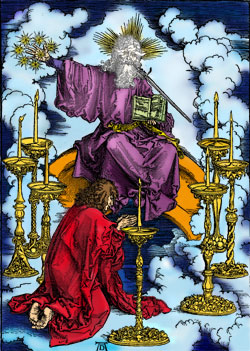 The “Real” Jesus (Segment II, Paragraphs 1-2)
The “Real” Jesus (Segment II, Paragraphs 1-2)
“Father, I desire that they also, whom You have given Me, be with Me where I am,
so that they may see My glory which You have given Me…” ~John 17:24
God wants us to see him in the humbling-awe inspiring way he really is in Heaven right now…
2.1 God Is Everything (1:8)
“I am the Alpha and the Omega, the Beginning and the End” says the Lord, “who is and who was and who is to come, the Almighty” (1:8)
Who is speaking now? The speaker identifies himself as “the Lord” (κύριος/kurios), a title indicating God’s supreme authority (Strongs).
How does God describe himself in this verse?
-
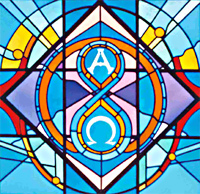 Alpha and Omega (cf. repetition of this title in Rev. 1:8, 1:11, 21:6, 22:13)
Alpha and Omega (cf. repetition of this title in Rev. 1:8, 1:11, 21:6, 22:13)
Alpha and Omega are the first and last letters of the greek alphabet (the language Revelation was written in). The original greek text actully uses the letters Α and Ω rather than them spelling them out in words.
What is significant about this?
Barlcay notes, “The Greeks used from alpha to omega and the Hebrews from aleph to tau to indicate completeness. For instance, Abraham kept the whole Law from aleph to tau. Here is the symbol that Jesus Christ has everything within himself and needs nothing from any other source.”
God is saying he’s everything from A to Z. You use letters to make words (like the word of God – John 1:1), words to make sentences, sentences to make paragraphs, paragraphs to communicate ideas. God is saying, “I am the sum total of communication.”
-
- The Beginning and End
Certain ancient manuscripts omit this phrase, others include it, so depending on what translation you are reading, this title may or may not be included. Clarke explains this variation as perhaps having started out as an “explanatory note” explaining the previous title more clearly that may have woven itself into the text over time. However, it is quite clear the meaning of this verse is not altered based on whether or not this title is included, so our time would be better spent dwelling on what it means than technicalities of translation.
This title fairly clearly shows transcendence of time. Beginning (ἀρχή/archē) is the same word used in the Genesis 1:1 and John 1:1, to say “in the Beginning…” Thayer’s Lexicon clarfies its meaning as the “that by which anything begins to be, the origin, the active cause”. End (τέλος/telos) on the other hand, Thayer clarifies as “termination, the limit at which a thing ceases to be, last in any succession, eternal”.
Barclay notes, “The Greeks said that Zeus was the beginning, the middle, and the end. The Jewish rabbis took over this idea and applied it to God, with their own interpretation. They said that, since God was the beginning, he received his power from no one; since he was the middle, he shared his power with no one; and since he was the end, he never handed over his power to anyone.” Thus, also this title hints at God’s authority through all time, power to both create/cause everything to be, without ceasing to be later on.
Will be repeated again in Revelation 22:13.
-
- who is and who was and who is to come
This title hints at God’s eternal and unchanging nature, having existed for all time past as well as all time to come, essentially outside the scope of time. This is a repetition from 1:4 and will occur again in 4:8.
| Application: How Big is Your God? |
| How big do you think Jesus is? Do you think he was just a “good example”, a person who existed at one small point in time? Or do you think of Jesus as God who encompasses all of human history? There’s a big difference in perspective…Is your mind grasping the scale of who Jesus really is?
|
-
- The Almighty
Almighty (παντοκράτωρ/ pantokratōr) – the ruler of all, having authority over all things
“He addeth the Almighty, to show that he was able to make his words good” (Poole)
It is, perhaps, interesting to note that although this title for God occurs well over half a dozen times in Revelation, that it only occurs in one other place in the entire new testament, 2Cor. 6:18, which is a quotation from Isaiah, making this title fairly unique to Revelation, and not used to describe anyone or anything except God himself.
“Is the Lord your reason for living, “the Alpha and the Omega” of your life? Honor the one who is the beginning and the end of all existence, wisdom, and power.” (Life Application Study Bible)
2.2 The Glorified Jesus (1:9-20)
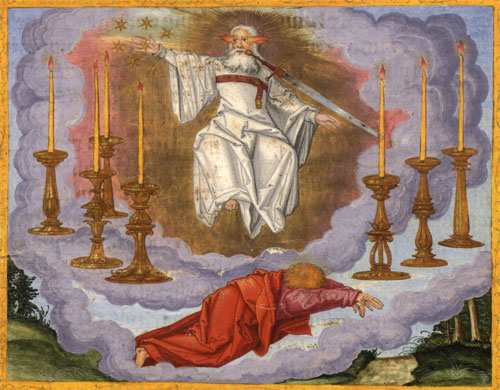
“Die Vision von den sieben Leuchtern”
“The Vision of the Seven Candlesticks” by Matthias Gerung, c.1530
From The Ottheinrich Bible which is the oldest surviving Illustrated Bible in German
(Rev 1:9) I, John, your brother and fellow partaker in the tribulation and kingdom and perseverance which are in Jesus, was on the island called Patmos because of the word of God and the testimony of Jesus. (10) I was in the Spirit on the Lord’s day, and I heard behind me a loud voice like the sound of a trumpet, (11) saying, “Write in a book what you see, and send it to the seven churches: to Ephesus and to Smyrna and to Pergamum and to Thyatira and to Sardis and to Philadelphia and to Laodicea.”
Here again, in this verse, the speaker changes back to John, as clearly indicated by “I, John”. The only other place this way of speaking occurs is in the apocolyptic vision of Daniel (“I, Daniel…” eg: Dan. 10:2), making this a farily unique reference in scripture.
How does John describe himself?
A brother – this emphasizes his equality with other believers (could have described himself like a father, for example, but he didn’t)
a fellow partaker in… “Companion (συγκοινωνὸς) – better, partaker with you…Κοινωνὸς, is a partner, associate. Σύν strengthens the term: partner along with. Compare John’s favorite word in the First Epistle, κοινωνία fellowship” (VWS).
- tribulation – this term is referring to the persecution, troubles, or trials faced by believers, NOT the “great” tribulation.
- and kingdom – along with”which are in Jesus” we know this refers to how we are a kingdom of priests unto God.
- and perseverence – “Translate, “endurance.” “Persevering, enduring continuance” (Act_14:22)” (JFB)
Where was John? An island called Patmos. (note that the greek tense of was indicates “came to be” rather than simply “was”). Patmos was a bare, rocky volcanic island in the Aegean sea. It had a cresent shaped harbor that made it navigationally important, the last stopping place on the way from Rome to Ephesus. Because of its rocky, barren nature it was selected as a penal colony by the Romans (TOJC).
Why was John on this Island? Because of “the word of God and testimony of Jesus”. Early Christian tradition says John was exiled to this island during Domitian’s reign over Rome (81-96AD), and only permitted to return to Ephesus after the death of Domitian. Domitian, according to historical records, banished Christians who refused to pay homage to Ceasar or roman Gods, calling them athiests. (TOJC) But it seems the important point, as what is mentioned in this verse is that it was related to his faith.
“It is a frequent pattern within Scripture that great revelation was often given to those close to God while in captivity outside Israel and while Jerusalem lay in ruins. We think of Ezekiel, Daniel, and now John. Often, the greatest revelation from God occurs when least expected and in the most unusual places (e.g., Paul in Arabia, Gal. 1:15-17.) ” TOJC
What was John doing when this vision took place? he was in the SPIRIT. This indicates, “that what he is about to describe involves supernatural revelation by means of a vision.” (TOJC) “Being ‘in the Spirit’ in the sense John describes is not something initiated by man. It is a sovereign action initiated by God in order to impart divine instruction. As Ezekiel describes it: “the hand of the Lord was upon him” (Eze_1:3).” (TOJC) “Peter, Paul, and John were passive recipients of that which God initiated” (cf. Acts 10:10, 22:17)
“In this sense, the experience is diametrically opposed to the ecstatic frenzies associated with cultish prophets (1Ki_18:28) and some modern movements wherein the person actively participates in bringing about an altered state of consciousness.” (TOJC)
When thid this vision take place? On the Lord’s day. Some interpret this to mean Sunday, however, other scripture simply calls Sunday the first day of the week. Others think the day is called of of the Lord simply because on that day the Lord revealed his vision.
Who did John hear? a loud voice that sounded like a trumpet. The voice was compared to a trumpet, signifying power and commanding attention. Trumpets, in scripture, accompanied many important events, eg: “announced the manifestation of God’s presence upon Mount Sinai (Exo_19:16; Exo_20:18). The year of jubilee when all debts were forgiven was heralded by the blast of a trumpet (Lev_25:9)” (TOJC)
Where was the voice located? Behind him. You might have to turn around to see Jesus.
What was he told by this voice? To write a book and send it to the seven (named) churches.
Who is this voice? Jesus.
(12) Then I turned to see the voice that was speaking with me. And having turned I saw seven golden lampstands; (13) and in the middle of the lampstands I saw one like a son of man, clothed in a robe reaching to the feet, and girded across His chest with a golden sash. (14) His head and His hair were white like white wool, like snow; and His eyes were like a flame of fire. (15) His feet were like burnished bronze, when it has been made to glow in a furnace, and His voice was like the sound of many waters. (16) In His right hand He held seven stars, and out of His mouth came a sharp two-edged sword; and His face was like the sun shining in its strength.
What is significant about John turning to the voice speaking to him? He’s listening, paying attention to Jesus, taking heed, concerned and interested as to who was making these fantastic claims of being almighty. Turning requires action, paying attention. He might not have seen the lampstands nor Jesus had he not turned towards God. “John turned to see what he heard and found it led to a deeper understanding and renewed appreciation of Jesus Christ.” (Courson).
What is the first thing John sees when he turns? He sees seven golden lampstands.
What is the significance of/symbolism in lampstands? A lampstand (sometimes also called candlesticks in some translations, however, oil lamps were much more commonly used than candles) is used to hold light. In this particular case, the answer is given a few verses later: in 1:20 we learn they represent the 7 churches, ie: the complete church.
What is significant about their color or material? “These seven lamps represented the seven Churches, in which the light of God was continually shining, and the love of God continually burning. And they are here represented as golden, to show how precious they were in the sight of God. This is a reference to the temple at Jerusalem, where there was a candlestick or chandelier of seven branches; or rather six branches; three springing out on either side, and one in the center. See Exo. 25:31-37. …the temple of Jerusalem was a type of the whole Christian Church.” (Clarke)
What is the significance of Jesus being amidst the 7 lampstands? Jesus is surrounded by the church. “For where two or three are gathered together in My name, I am there in the midst of them.” (Mat 18:20)
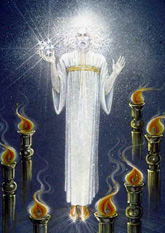
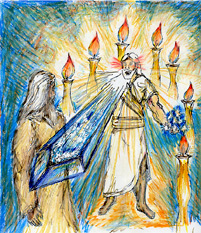

Various illustrations of this heavenly Jesus
Revelation 1:12-16 presents a vision of powerful heavenly Jesus Christ. This Jesus is a picture of authority, his true self, not the humbled earthly version, but Jesus in his true power and might. He’s setting the record straight about who he really is in an “unequivocally awesome” description. His voice is clear, loud, powerful, not confusing when he speaks, even matter obeys him. Are you going to make Jesus repeat himself? He is so full of vitality that his skin glows. He’s royalty, an authoritative majestic ruler over everything imaginable. This should have an effect on you.
Summary of this Description:
|
His…
|
Is Compared to…
|
In…
|
Important characteristics
|
|
Overall Appearance
|
A Son of man
|
1:13
|
Similar but not identical (“like”). Substantial difference: This is the glorified Jesus.
|
|
Voice
|
A trumpet
|
1:15
|
Startling, forceful, gets your attention, hard to miss. No question when Jesus is speaking.
|
|
Clothing
|
Clothes of royalty (robe to the floor, girded w/ golden sash)
|
1:13
|
Long robes was impractical for people who do their own laundry and walk on dirt roads. Gold is expensive. Implication: Jesus = royalty. Jesus spent 33 years of an eternal existence humbled, but that’s not who he is. He is the most majestic ruler of everything you can imagine. The golden sash likely symbolizes righteous and faithfulness in his judgments (Isa. 11:5).
|
|
Hair
|
White wool, snow
|
1:14
|
Blindingly white. Not brown like we usually picture his hair. Symbolic, perhaps, of purity (cf. Isa. 1:18) and cleaning of sin.
|
|
Face
|
Sun shining in its strength
|
1:16
|
Midday sun is relentless, beats down on you, lacking shadows or refuge.
|
|
Eyes
|
Flame of fire
|
1:14
|
To be able to see this flame of fire coming out of something that looks like the sun, how bright must this be? This isn’t like a candle flickering (more like blowtorches) We are talking bright, sharp, penetrating, penetrating enough to see even into the thoughts of people. “speaks of perfect knowledge, infallible insight, and inescapable scrutiny” (BBC)
|
|
Feet
|
Burnished bronze glowing in a furnace
|
1:15
|
Like molten metal, Jesus is so full of vitality that his skin glows. Brass is the most durable metal, this is an emblem of his stability and permanance, and is also typically symbolic of judgment throughout the bible.
|
|
Voice
|
Sound of many waters
|
1:15
|
Really loud, thunderous like Niagara Falls. You can feel it before you see it and see why matter obeys (are you going to make Jesus repeat himself?). When Jesus speaks, there’s no question that he spoke.
|
|
Seeing Jesus
|
A dead man
|
1:17
|
Seeing this Jesus makes you think you’d died.
|
![]() Jesus’s voice is clear and distinguishable. You shouldn’t be confused about the voice of the Lord.
Jesus’s voice is clear and distinguishable. You shouldn’t be confused about the voice of the Lord. ![]()
What did Jesus have in his right hand? Seven stars. Having them in his right hand signifies possession, power, control, or honor (BBC).
What came out of Jesus’s mouth? A sharp two-edged sword. From Hebrews 4:12, we have a pretty good idea this sword, also called “the word of God” is able to judge.
Is there anything noticable as a whole about this vision of Jesus? There seems to be a theme about judgement symbols running throughout. In context, it would seem to make sense that perhaps God is showing he is supremely qualified to judge his churches before presenting his messages to the churches.
“For it is time for judgment to begin with the household of God; and if it begins with us first, what will be the outcome for those who do not obey the gospel of God?” (1Pe 4:17)
The Effect of Seeing Jesus (1:17-20)
17 When I saw Him, I fell at His feet like a dead man. And He placed His right hand on me, saying, “Do not be afraid; I am the first and the last, 18 and the living One; and I was dead, and behold, I am alive forevermore, and I have the keys of death and of Hades. 19 “Therefore write the things which you have seen, and the things which are, and the things which will take place after these things. 20 “As for the mystery of the seven stars which you saw in My right hand, and the seven golden lampstands: the seven stars are the angels of the seven churches, and the seven lampstands are the seven churches.
John fell at his feet like a dead man (1:17). The vision was so powerful he thought it had killed him. Reading this paragraph you couldn’t have even scratched the surface of what John’s seen. You would have thought there’s no ability to survive it.
| Application: Committed to Jesus? |
| Are you struggling, wondering whether Jesus is really worth committing to? If you are, the cause of your struggle could be a false idea of who Jesus is. If you encountered Jesus to his face, you’d be thankful to have life, not wondering whether Jesus is worth “committing to”. View Jesus in his full glory and power. |
How does Jesus react to John’s shock and surprise? Jesus reaches out and tries to reassure John, “do not be afraid”, perhaps also to help him back up to his feet (although this is not stated specifically either way).
What does Jesus tell John?
- do not be afraid – or “fear not”. this is not unncommon in scripture as a reassuance by God when him or an angel appears to someone and is afraid (eg: to the Disciples in Mt. 14:27, to Abraham in Gen 15:1). After these powerful manifestations of seeing God’s awesome power, this reassurance could not come at a better time. “amidst the most awful manifestations of divine power, the simple assurance that our Redeemer is near us is enough to allay our fears, and diffuse calmness through the soul.” (Barnes)
- I am the first and the last – eternal
- He is the living one, was dead but alive forever more… resurrected self, power of his own death
- has keys to death and hades… control or power over death, judgment
How does Jesus describe himself to John? Is there anything significant about this description?
What cause and effect is going on in verse 19?
Don’t be afraid (v 17)… therefore write this down. Saying: Let’s get clear to the church how I really am… And you wonder why the devil wants you to read this book LAST? Jesus = much bigger and purer than you think.
What mystery is revealed in verse 20?
Application Questions:
![]() Is your life based on what you see in this paragraph? Who Jesus really is?
Is your life based on what you see in this paragraph? Who Jesus really is?
![]() Are you seeking to live in the Jesus reality, or the American Dream? (a material focus = empty, more a nightmare than a dream)
Are you seeking to live in the Jesus reality, or the American Dream? (a material focus = empty, more a nightmare than a dream)
![]() Until you understand the truth of who Jesus is you can’t life your life by it.
Until you understand the truth of who Jesus is you can’t life your life by it. ![]()
![]() The church needs to know who Jesus is and base itself on who Jesus is.
The church needs to know who Jesus is and base itself on who Jesus is. ![]()
| Application: What is shaping our Church Culture? | ||||||||||||||
Who’s Impacting Who?
Problems with Popular “Church Trends”:
This is not to bash or deny the good of these movements (they’ve had positive impacts). But the church should not be a chameleon or yo-yo. Movements all expire eventually, they won’t last.We all carry with us our own sense of style, even if we aren’t trying to make a fashion statement. Churches all have personalities. |
Seven spirits
Seven is a significant number in revelation. Lots of repetition of 7. Seven is the Number of completion. From text: dealing with end times a completion of the human experience with sin. The author is not belaboring who the seven spirits “are”. Just is in his glory right now. What prayer did John record in his gospel? (Jn 17:24) Father may they see me with the glory I had in heaven. (As God really is)…humbling, awe-inspiring.
Looking Forward
We go from this description of Jesus into letters to the churches with phrases from this vision. The vision of Jesus becomes the cause that produces the letters to the churches (because of who Jesus is, this is how the church should be…)
|
Vision of |
|
Letters to |
This should encourage you, embolden you. There are no limits for you.
One of the major repetitions in this segment is “he who has an ear, let him hear what the spirit says.” God is speaking loudly hear (did you notice his voice was as loud as a trumpet?) trying to communicate something to us. Are you listening?
Segment II continues on the following page.

